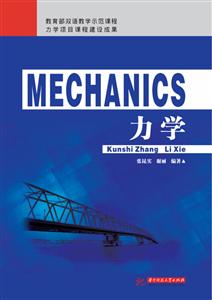力学
本书特色
[
本书是教育部、财政部联合批准的g家级双语教学示范课程——力学课程英文版教材建设的成果。本书根据我国现行高等院校物理专业力学课程教学大纲编写,包括十二章内容:质点运动学、牛顿运动定律、动量、动能和势能、角动量、万有引力定律、刚体力学、弹性体的应力与应变、流体力学、振动、波动和声、狭义相对论。
本书抓住国际、国内优秀物理学教材的编写特点编写,结构清晰、简明扼要。本书加强了力学与现代科技、日常生产和生活及其他学科的联系,努力将计算物理的方法融入力学课程教学之中。
本书可作为高等院校本科物理类专业力学课程的双语教材,也可供相关专业师生参考。
]
内容简介
[
Abstract
This English version Mechanics is the product of the curriculum construction of the ‘National Bilingual Teaching Demonstration Course’ — Mechanics, approved by the Ministry of Education of China and the Ministry of Finance of China. This textbook is based on the current syllabus of Mechanics course for the students majoring physics. The content of this textbook covers twelve chapters: kinematics, Newton’s laws of motion, momentum, mechanical energy, angular momentum, gravitation, rigid body, elasticity, fluids, oscillations, waves, special theory of relativity.
This textbook focuses on absorbing and utilizing writing characteristics from both foreign and domestic popular Physics textbooks. The structure of this book is clear and the teaching materials are presented to be concise and to the point. This book reinforces the close links between Mechanics and modern science and technology, daily production, daily life and other subjects, and strives to integrate computational physics into the process of the teaching of Mechanics course.
This book can be used as the textbook for bilingual teaching of Mechanics course for the undergraduate students who majoring physics (or physics-related specialty) in universities and colleges, and it is also available for reference by other teachers and students.
内容简介
本书是教育部、财政部联合批准的g家级双语教学示范课程——力学课程英文版教材建设的成果。本书根据我国现行高等院校物理专业力学课程教学大纲编写,包括十二章内容:质点运动学、牛顿运动定律、动量、动能和势能、角动量、万有引力定律、刚体力学、弹性体的应力与应变、流体力学、振动、波动和声、狭义相对论。
本书抓住国际、国内优秀物理学教材的编写特点编写,结构清晰、简明扼要。本书加强了力学与现代科技、日常生产和生活及其他学科的联系,努力将计算物理的方法融入力学课程教学之中。
本书可作为高等院校本科物理类专业力学课程的双语教材,也可供相关专业师生参考。
]
作者简介
[
张昆实 谢丽,高校教师,从事专业教学数十年,教学经验丰富。
]
目录
Contents
Chapter 1 Kinematics of Particles………………………………………………………………1
1.1 Reference Frame and Particle Model……………………………………………………………….2
1.2 Kinematical Equation of a particle…………………………………………………………….3
1.3 Instantaneous Velocity and Instantaneous Acceleration………………………………………5
1.4 Rectilinear motion……………………………………………………………………………10
1.5 Projectile Motion…………………………………………………………………………….14
1.6 Curvilinear Motion…………………………………………………………………………..20
1.7 Relative Motion and Galilean transformation……………………………………………………………26
Review & Summary ……………………………………………………………………………..…………
Discussion Questions ……………………………………………………………………………..…………
Problems ……………………………………………………………………………..………………………
Chapter 2 Newton’s Laws of Motion………………………………………………………….
2.1 Newton’s Laws of Motion ……………………………………………………………………………
2.2 General Forces Encountered in Everyday Life …………………………………………………………
2.3 Applications of Newton’s Laws of Motion ………………………………………………………….
2.4 Non-inertial Frames and inertial Forces ………………………………………………………………..
*2.5Numerical integration ……………………………………………………………………………..
Review & Summary ……………………………………………………………………………..…………
Discussion Questions ……………………………………………………………………………..…………
Problems ……………………………………………………………………………..………………………
Chapter 3 Momentum………………………………………………………………………….
3.1 Momentum and Newton’s Second Law of Motion……………………………………………………….
3.2 Impulse and the Impulse-Momentum Theorem………………………………………………………..
3.3 Center of Mass and Kinetic Theorem of the Center of Mass…………………………………………………..
3.4 The Law of Conservation of Momentum……………………………………………………………………
3.5 The Motion of Rocket……………………………………………………………………………………….
Review & Summary ……………………………………………………………………………..…………
Discussion Questions ……………………………………………………………………………..…………
Problems ……………………………………………………………………………..………………………
Chapter 4 Work and Energy…………………………………………………………………..
4.1 Work……………………………………………………………………………………………………
4.2 The work-kinetic energy theorem……………………………………………………………………….
4.3 Conservative force, nonconservative force and potential energy……………………………………………
4.4 The law of conservation of mechanical energy…………………………………………………………..
4.5 Collisions………………………………………………………………………………………………
Review & Summary ……………………………………………………………………………..…………
Discussion Questions ……………………………………………………………………………..…………
Problems ……………………………………………………………………………..………………………
Chapter 5 Angular momentum……………………………………………………………….
5.1 Angular momentum of a particle with respect to a reference point ………………………………………
5.2 Angular momentum of a particle with respect to a fixed axis ………………………………………………..
5.3 Angular momentum of a system of particles………………………………………………………………
Review & Summary ……………………………………………………………………………..…………
Discussion Questions ……………………………………………………………………………..…………
Problems ……………………………………………………………………………..………………………
Chapter 6 Gravitation…………………………………………………………………………
6.1 Kepler’s Laws………………………………………………………………………………
6.2 Newton’s Law of Universal Gravitation……………………………………………………………….
6.3Gravitational Field and Satellite Motion………………………………………………………………
6.4Gravitational Potential Energy and Three Cosmic Velocities………………………………………..
Chapter 7 Mechanics of Rigid Bodies……………………………………………………….
7.1 Classification of the Motion of Rigid Bodies…………………………………………………………
7.2 Translational Motion and Theorem of Motion of COM……………………………………………………
7.3 Rotation of Rigid Body about a Fixed Axis………………………………………………………………..
7.4 Rotational Inertia Calculations…………………………………………………………………..
7.5 Angular Work-kinetic Energy Theorem and
Moment of Impulse-angular Momentum Theorem……………………………………………………………
7.6 Plane-parallel Motion of Rigid Bodies………………………………………………………………..
7.7 Equilibrium of Rigid Bodies…………………………………………………………………….
7.8 Procession of a Gyroscope………………………………………………………………………
Review & Summary ……………………………………………………………………………..…………
Discussion Questions ……………………………………………………………………………..…………
Problems ……………………………………………………………………………..………………………
Chapter 8 Fluid Mechanics…………………………………………………………………..
8.1 Static hydrodynamics ……………………………………………………………………………………..
8.2 Motion of an idea fluid……………………………………………………………………………………..
8.3 Bernoulli’s Equation…………………………………………………………………………………..
8.4 Motion of viscous fluid…………………………………………………………………………………….
Review & Summary ……………………………………………………………………………..…………
Discussion Questions ……………………………………………………………………………..…………
Problems ……………………………………………………………………………..………………………
Chapter 9 Elasticity…………………………………………………………………………
9.1Tensile and Compressive Deformation of Elastic Body………………………………………………………
9.2 Shearing Deformation of Elastic Body…………………………………………………………………….
9.3 Bending and Twisting Deformation……………………………………………………………………………
Review & Summary ……………………………………………………………………………..…………
Discussion Questions ……………………………………………………………………………..…………
Problems ……………………………………………………………………………..………………………
Chapter 10 Oscillations…………………………………………………………………………
10.1 Simple harmonic motion………………………………………………………………………………
10.2 Comparing SHM with UCM………………………………………………………………………….
10.3 Energy in simple harmonic oscillator…………………………………………………………………
10.4 Combination of SHM…………………………………………………………………………………
10.5 Damped oscillation……………………………………………………………………………………
10.6 Forced oscillation and resonance…………………………………………………………………………..
Review & Summary ……………………………………………………………………………..…………
Discussion Questions ……………………………………………………………………………..…………
Problems ……………………………………………………………………………..………………………
Chapter 11 Wave Motion and Sound Waves……………………………………………….
11.1 Basic concept of waves…………………………………………………………………………………..
11.2 Mathematical description of a wave………………………………………………………………………..
11.3 Wave equation and wave speed…………………………………………………………………………..
11.4 Energy of waves………………………………………………………………………………………….
11.5 Huygens principle, Reflection and Diffraction of waves…………………………………………………
11.6 Superposition and Interference……………………………………………………………………………
11.7 Standing waves………………………………………………………………………………………
11.8 Sound waves………………………………………………………………………………………………
11.9 The Doppler Effect………………………………………………………………………………………..
Review & Summary ……………………………………………………………………………..…………
Discussion Questions ……………………………………………………………………………..…………
Problems ……………………………………………………………………………..………………………
Chapter 12 Special Theory of Relativity…………………………………………………
12.1 The Background of the Birth of the Special Theory of Relativity………………………………………….
12.2 Einstein’s Postulates of Relativity and the Lorentz Transformations Equations………………………..
12.3 The Space-Time Theory of Relativity……………………………………………………………………..
12.4 The Velocity Transformation of Relativity………………………………………………………….
12.5 Relativistic Momentum and Relativistic Energy……………………………………………….………
12.6 Introduction to the General Theory of Relativity ……………………………………………………..
Review & Summary ……………………………………………………………………………..…………
Discussion Questions ……………………………………………………………………………..…………
Problems ……………………………………………………………………………..………………………
封面

书名:力学
作者:张昆实
页数:440
定价:¥78.0
出版社:华中科技大学出版社
出版日期:2018-04-01
ISBN:9787568035545
PDF电子书大小:69MB 高清扫描完整版
